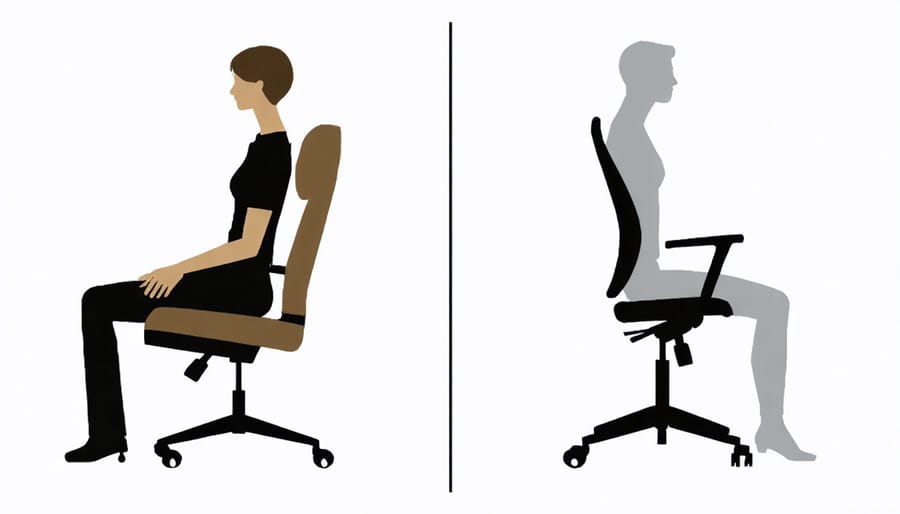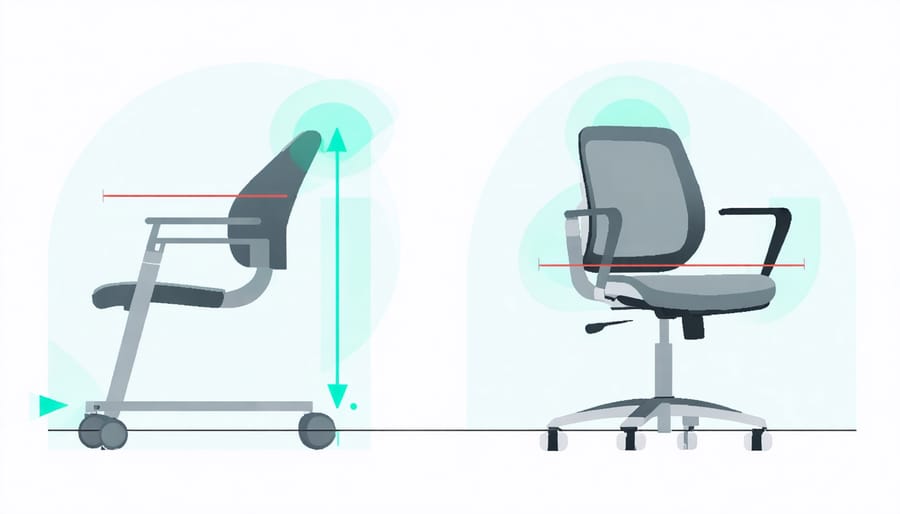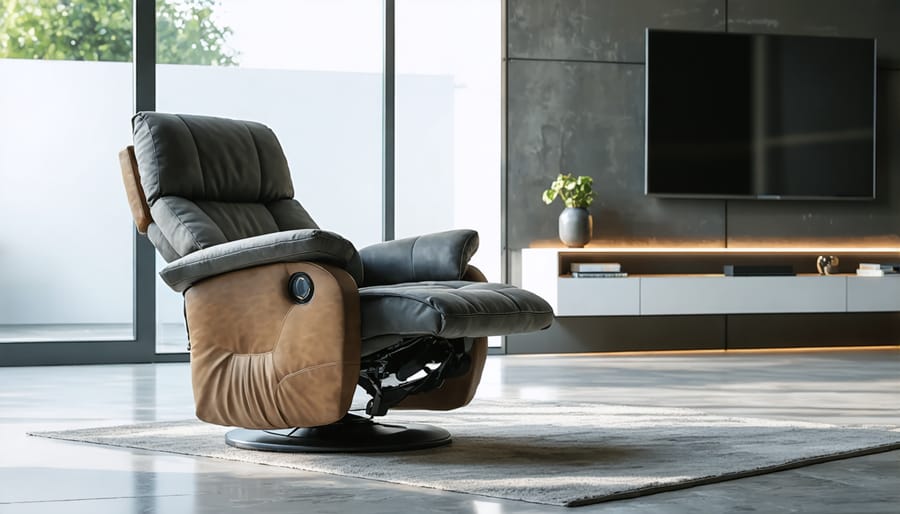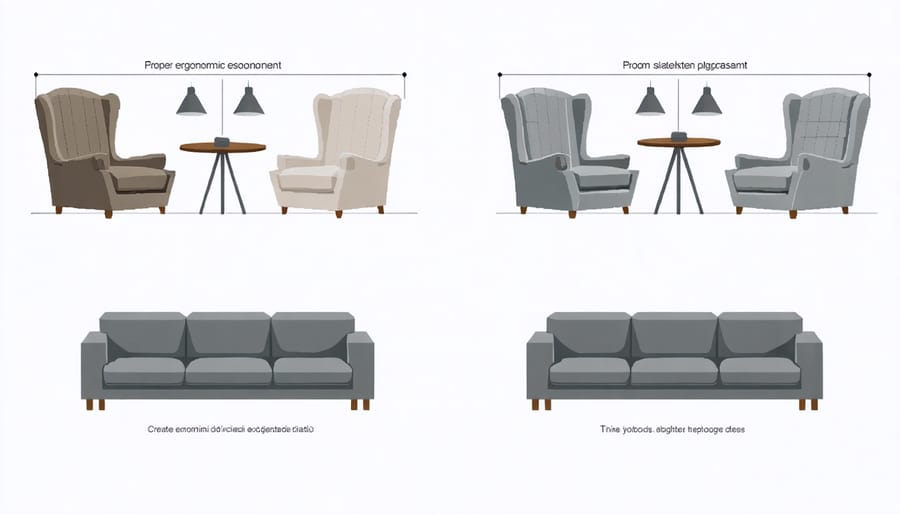Transform your living room into a sanctuary of comfort with ergonomically designed chairs that prevent chronic pain and discomfort. Modern ergonomic chairs blend seamlessly with contemporary décor while providing essential support for your spine, neck, and shoulders during those long Netflix binges or cozy reading sessions.
Select chairs featuring adjustable lumbar support, memory foam cushioning, and proper seat depth to accommodate your unique body measurements. The perfect ergonomic living room chair should allow your feet to rest flat on the floor while maintaining a 90-degree angle at your knees – a crucial factor often overlooked in traditional furniture design.
Today’s market offers sophisticated options from classic recliners with built-in massage features to sleek, minimalist designs with innovative posture-supporting technology. Whether you’re creating a reading nook or furnishing an entire living space, investing in ergonomic seating means investing in your long-term comfort and well-being without sacrificing style.
For those mindful of both health and aesthetics, contemporary ergonomic chairs come in an array of luxurious fabrics and finishes, ensuring your comfort-first choice becomes a stunning centerpiece rather than just another piece of furniture.
Why Traditional Living Room Chairs Fall Short
We’ve all been there – sinking into that beautiful but ultimately uncomfortable living room chair after a long day, only to find ourselves shifting positions every few minutes. Traditional living room chairs, while often stylish, frequently prioritize aesthetics over actual comfort and proper body support.
The most common issue with conventional chairs is their one-size-fits-all approach. These chairs typically feature fixed dimensions that don’t account for different body types or sitting preferences. The seat depth is often too deep or too shallow, forcing you to either perch uncomfortably at the edge or slouch backward, neither of which promotes good posture.
Another significant drawback is inadequate lumbar support. Many traditional chairs have a flat or minimally curved backrest that fails to maintain the natural S-curve of your spine. This can lead to lower back strain, especially during extended sitting sessions while watching TV or engaging in conversation with friends and family.
The armrests on conventional chairs can also be problematic. They’re usually set at a fixed height and width, which may force your shoulders into an unnatural position or leave your arms unsupported. This can result in shoulder tension and neck strain over time.
Traditional chairs often use cushioning materials that compress and lose their support quality relatively quickly. While they might feel plush initially, many conventional foam materials don’t distribute weight evenly or maintain their shape, leading to pressure points and discomfort after extended use.
The seat angle is another overlooked aspect. Most traditional chairs have completely flat seats or slight backward tilts that can encourage poor posture and put unnecessary pressure on your tailbone. This design doesn’t consider the natural positioning of your hips and pelvis when sitting.
These shortcomings don’t just affect comfort – they can contribute to long-term posture issues, muscle strain, and chronic discomfort. As we spend more time at home, having properly supportive seating isn’t just a luxury – it’s a necessity for maintaining our physical well-being.


Key Features of Ergonomic Living Room Chairs
Proper Lumbar Support
When it comes to comfortable seating, proper lumbar support is non-negotiable. This crucial feature helps maintain the natural curve of your lower back, preventing strain and discomfort during those long Netflix marathons or cozy reading sessions. Quality ergonomic chairs typically include a cushioned lumbar region that sits right at the small of your back, usually between 6-12 inches above the seat.
Look for chairs with adjustable lumbar support, which allows you to customize the pressure and position to match your unique spine curvature. Some high-end models feature dynamic support that responds to your movements, while others offer removable lumbar pillows for greater flexibility.
The benefits of proper lumbar support are significant: it helps maintain good posture, reduces lower back pain, and prevents the slouching that often leads to long-term spinal issues. When testing a chair, make sure the lumbar support feels firm but not rigid, and sits comfortably against your lower back without creating pressure points.
For the best results, choose a chair where the lumbar support aligns naturally with your spine when you’re sitting all the way back in the seat.
Seat Depth and Height
When it comes to selecting the perfect ergonomic living room chair, understanding proper seat measurements is crucial. Following basic ergonomic design principles, your ideal seat depth should allow you to sit with your back against the backrest while leaving 2-3 inches between the back of your knees and the seat’s edge.
For most adults, a seat depth between 19-21 inches works well, though taller individuals might prefer up to 23 inches. As for height, your feet should rest flat on the floor with your thighs parallel to the ground. A seat height of 16-18 inches typically accommodates most people comfortably.
Look for chairs with adjustable features when possible. Some modern ergonomic living room chairs offer customizable seat depth through sliding mechanisms or removable back cushions. This adaptability ensures comfort for different family members and guests. Remember, when your feet dangle or your knees rise above your hips, it’s a sign that the chair’s dimensions aren’t right for you.
Armrest Design
Proper armrest design plays a crucial role in the overall comfort and ergonomic benefits of your living room chair. Well-positioned armrests support your elbows and forearms, reducing shoulder strain and promoting better posture during extended sitting periods.
The ideal armrest height should allow your arms to rest naturally at a 90-degree angle, with your shoulders relaxed and elbows close to your body. Look for chairs with adjustable armrests that can be customized to your body proportions – this feature is especially valuable if multiple family members use the same chair.
Width and padding are equally important considerations. Armrests should be wide enough to support your entire forearm comfortably, typically around 2-4 inches. Soft, resilient padding prevents pressure points and numbness during long sitting sessions, while firm underlying support maintains proper arm positioning.
Some modern ergonomic chairs feature 3D or 4D adjustable armrests, allowing you to modify not just the height, but also the width, depth, and angle. While these options might come at a premium, they offer maximum customization for optimal comfort and support.
Popular Ergonomic Chair Styles for Living Rooms
Modern Recliners
Modern recliners have evolved far beyond the bulky, oversized chairs of the past. Today’s ergonomic recliners combine sophisticated design with advanced comfort features that support your body’s natural alignment. Many models offer customizable settings, allowing you to adjust the headrest, lumbar support, and footrest independently for your perfect position.
Look for features like zero-gravity positioning, which elevates your feet above your heart to reduce pressure on your spine and promote better circulation. Power recline functions make adjustments effortless, while memory settings store your preferred positions for consistent comfort. Some advanced models even include built-in massage and heat therapy functions to soothe tired muscles.
Materials have also improved significantly, with high-density memory foam and responsive cushioning that maintains its shape over time. Many contemporary recliners feature breathable fabrics or premium leather that’s both durable and easy to clean. Slim profiles and sleek designs mean these chairs can complement any modern living space without overwhelming the room.
Smart features are becoming increasingly common, with USB charging ports and app-controlled settings available in premium models. Some recliners even offer health monitoring capabilities, tracking your sitting patterns and suggesting position changes for optimal comfort throughout the day.
When choosing a modern recliner, consider options with smooth-gliding mechanisms and quiet motors to ensure a peaceful environment. Look for models with adequate neck and lumbar support to maintain proper posture during extended periods of relaxation.

Accent Chairs with Ergonomic Features
Gone are the days when you had to choose between style and comfort. Today’s accent chairs seamlessly blend ergonomic features with eye-catching designs, proving that you can have the best of both worlds. These statement pieces not only add personality to your living room but also provide crucial support for your body.
Look for accent chairs with built-in lumbar support that’s subtly integrated into the chair’s design. Many contemporary options feature gently curved backrests that naturally follow your spine’s contours while maintaining a sleek silhouette. Upholstered options with memory foam padding offer excellent pressure relief without compromising the chair’s aesthetic appeal.
Consider chairs with slightly angled seats and waterfall edges, which reduce pressure on your thighs while maintaining an elegant profile. Some designers have masterfully incorporated adjustable features, like hidden recline mechanisms or rotating bases, into chairs that could easily pass for purely decorative pieces.
Mid-century modern inspired chairs often excel in this category, as their organic shapes naturally complement ergonomic principles. Look for options with arms at the right height to support your elbows while typing or reading, and ensure the seat depth allows you to sit with your feet flat on the floor.
When selecting your accent chair, pay attention to the upholstery material. Performance fabrics offer both durability and comfort, while maintaining a sophisticated appearance. Remember, the most stylish chair is the one that keeps you comfortable for hours.
Reading and Lounge Chairs
Reading and lounge chairs are the unsung heroes of living room comfort, designed specifically for those long reading sessions or relaxing evenings. When choosing the perfect chair, look for models with high backs that provide full support for your spine and neck. A good reading chair should have armrests at the right height – ideally allowing your elbows to rest naturally while holding a book or tablet.
Consider chairs with adjustable features like reclining capabilities and footrests, which let you customize your sitting position throughout the day. Memory foam cushioning is particularly effective in these chairs, as it molds to your body while maintaining its shape over time. The seat depth should allow you to sit with your feet flat on the floor while your back remains against the backrest.
Popular styles include wingback chairs, which offer extra head and neck support while creating a cozy nook feel, and contemporary recliners that blend seamlessly with modern décor. Look for chairs with breathable fabrics like cotton or performance materials that stay cool during extended sitting sessions.
Expert tip: Choose a chair that’s slightly wider than standard dining chairs to allow for position changes and natural movement. Adding a small side table and adjustable reading lamp can transform your chair into the perfect reading sanctuary.
Choosing the Right Ergonomic Chair
Room Size and Layout
When choosing ergonomic living room chairs, it’s crucial to consider your space’s dimensions and create an optimal room layout. Start by measuring your living room, noting not just the overall dimensions but also the space you can dedicate to seating. A good rule of thumb is to leave at least 30 inches of walking space around each chair for comfortable movement.
Consider the chair’s footprint when both upright and reclined if you’re choosing adjustable models. Many ergonomic chairs, especially recliners, need additional clearance when fully extended. For compact spaces, look for wall-hugger designs that require only 3-6 inches of wall clearance to recline fully.
The shape of your room also influences chair selection. L-shaped rooms might benefit from swivel chairs that can face different areas, while narrow rooms work better with slim-profile chairs. Pay attention to the chair’s scale relative to your other furniture – an oversized ergonomic chair can overwhelm a small space, while a petite chair might look out of place in a spacious room.
Don’t forget to consider traffic flow patterns. Position chairs away from high-traffic areas to prevent them from becoming obstacles. If you’re planning multiple seating pieces, arrange them to encourage conversation while maintaining easy access to entries, windows, and other functional areas of your room.

Material and Maintenance
When investing in an ergonomic living room chair, understanding material choices and maintenance requirements is crucial for long-term satisfaction. High-quality materials like genuine leather offer durability and easy cleaning with just a damp cloth, though they require occasional conditioning to prevent cracking. Fabric upholstery provides excellent breathability and comfort but needs regular vacuuming and prompt stain treatment.
For maximum longevity, look for frames made from solid hardwood or metal, as these materials resist warping and maintain structural integrity over time. Cushioning materials matter too – high-density foam maintains its shape better than cheaper alternatives, while memory foam offers superior comfort but may need occasional fluffing to restore its form.
Regular maintenance is simple but essential. Rotate cushions monthly to ensure even wear, tighten any loose screws or hardware quarterly, and clean according to the manufacturer’s instructions. For chairs with moving parts, such as recliners or swivels, apply lubricant to mechanisms annually to prevent squeaking and ensure smooth operation.
Pay attention to weight limits and usage guidelines to prevent premature wear. Keep chairs away from direct sunlight to prevent fabric fading and material degradation. For spots and spills, always blot rather than rub, and consider applying a fabric protector to new chairs for added stain resistance.
With proper care, a quality ergonomic chair can maintain its comfort and appearance for many years, making it a worthwhile investment in your home’s comfort and style.
Styling Tips for Ergonomic Chairs
Integrating an ergonomic chair into your living room doesn’t mean sacrificing style for comfort. With thoughtful styling, your health-conscious seating can become a stunning focal point that enhances your space’s overall aesthetic.
Start by selecting a chair with a color palette that complements your existing décor. Natural tones like beige, gray, or brown offer versatility, while bold colors can create an eye-catching accent piece. Consider adding texture through throws or small accent pillows that don’t compromise the chair’s ergonomic benefits.
Position your chair strategically within the room’s layout. Create a cozy reading nook by placing it near a window or complement it with ambient lighting solutions for a warm, inviting atmosphere. Pair your ergonomic chair with a small side table to maintain functionality without cluttering the space.
For a cohesive look, echo elements of your chair’s design throughout the room. If your chair features wooden components, incorporate similar wood tones in nearby furniture or décor. Metal accents can be matched with lighting fixtures or artwork frames.
Consider these style-enhancing accessories:
– A sleek floor lamp for task lighting
– A compact ottoman that maintains proper ergonomic positioning
– A coordinating throw blanket that adds visual interest
– A small lumbar pillow in a complementary pattern
Remember to maintain clear space around your ergonomic chair to showcase its design and ensure easy access to adjustment controls. The key is finding the sweet spot between functionality and aesthetics, creating a space that’s both comfortable and visually appealing.
When selecting fabrics for nearby furniture pieces, choose materials that complement your ergonomic chair’s upholstery while maintaining a balanced visual weight throughout the room. This creates a harmonious look that makes your ergonomic choice feel intentional rather than out of place.
Creating a comfortable and ergonomic living space isn’t just about following trends – it’s an investment in your daily comfort and long-term well-being. Throughout this guide, we’ve explored how ergonomic living room chairs can transform your relaxation time from merely adequate to truly exceptional. From understanding the importance of proper lumbar support to considering adjustable features and materials, each element plays a crucial role in creating the perfect seating solution.
Remember that the best ergonomic chair is one that fits your specific needs, body type, and lifestyle. Whether you’ve chosen a classic recliner, a modern ergonomic accent chair, or a sophisticated reading chair, the key is to prioritize both comfort and proper posture. Don’t compromise on features that support your body’s natural alignment just for the sake of aesthetics – today’s market offers plenty of stylish options that don’t sacrifice ergonomic benefits.
Take time to test different chairs when possible, pay attention to adjustability features, and consider how the chair will fit into your daily routine. Your living room should be a sanctuary where you can truly unwind without worrying about discomfort or strain. By choosing ergonomic seating solutions, you’re not just buying furniture – you’re investing in your health, comfort, and quality of life.
Start implementing these ergonomic principles in your living space today, and experience the difference that thoughtful seating choices can make in your daily comfort and overall well-being.
